[ad_1]

By: Roberto J. Rodríguez, Assistant Secretary, Office of Planning, Evaluation and Policy Development
We need a system that’s inclusive, that delivers value, and that produces equitable outcomes. We need transparency in data more now than ever before.
– Secretary Miguel Cardona
The U.S. Department of Education’s College Scorecard is a free online tool to help students of all ages, families, educators, counselors, and other college access professionals make data-informed decisions when choosing a college or university to attend. Through an open and easy-to-use website, the Scorecard supports students on their pathway to college and future careers by increasing the transparency of information that will help them understand the benefits of a higher education, such as college costs, student debt, graduation rates, admissions test scores and acceptance rates, student body diversity, post-college earnings, and much more.
Under Secretary Cardona’s leadership, the Department of Education is working to Raise the Bar in education by reimagining pathways to college and careers and by building a more inclusive, accessible higher education system that delivers value and upward mobility to students. The College Scorecard advances these goals by leveraging open data and technology to help young people and adults, families, and those in the workforce better navigate their options for college and career-readiness, steer clear of programs that fall short of delivering a strong return on investment, and choose a path that will prepare them for well-paying jobs and rewarding careers in today’s globally competitive world.
With this update, we are pleased to announce several new features on the College Scorecard, including recent data on student debt and earnings from the National Student Loan Data System and the Internal Revenue Service (IRS), and the ability for users to explore information on campus and faculty diversity, graduate school outcomes, and longer-term earnings by college. This year’s enhancements include the following:
- For the very first time, data on the median earnings of former graduates four years after completion of their requisite field of study. Previously, only three-year post-completion earnings data were available for individual fields of study within institutions. This year’s Scorecard features the most recent calculations available from the National Student Loan Data System and the IRS, so that students can understand which college and university graduates take on less loan debt and which former students earn more after college. The Scorecard will continue to publish additional years of earnings as they become available to help students better understand the short- and long-term benefits of earning a credential, especially in fields where many students pursue graduate degrees to realize their full earnings potential.
- New demographic data, including race/ethnicity data for full-time college staff and student-to-faculty ratios. With this new data, individuals will have a fuller picture of campus diversity as part of a school’s profile, including information about student body size, ratio of part-time to full-time students, socio-economic diversity of students, the student-to-faculty ratio, and race/ethnicity distributions for both the student body and for full-time staff.
- Greater information for prospective graduate students – not just undergraduates – on fields of study, earnings, and student debt trends. This information is particularly important given the significant investment and loan debt that students take on to pay for graduate programs. Users can now search for fields of study for all degree levels, including post-baccalaureate certificates, master’s degrees, and doctoral degrees. By selecting a field of study and degree type, they can view a list of schools that offer their field of study and quickly compare data on the earnings, debt, and number of students served. Prospective graduate students will now have easier access to more transparent data about which institutions leave students better off after attending.
Beyond expanding our College Scorecard’s data sets, users now benefit from a new, more user-friendly field of study interface that makes it easier for students and families to navigate the data, discover programs, and compare information on fields of study across multiple institutions.
Today’s updates are reflective of the Department’s commitment to continuously improve the College Scorecard so that it works for prospective students and families; to maintaining open and accessible postsecondary education data; and to promoting greater engagement in and awareness of postsecondary outcomes, including through a user-friendly web tool; downloadable files; and an application program interface (API) for web developers to integrate the data into their own tools.
Last year alone, customers accessed the College Scorecard over two million times. The Department will continue to raise the bar for transparency in postsecondary education through open and accessible data. Students deserve to know which colleges deliver education at a great value, reflect a diverse student population, and equip their graduates for success in the workforce. With the tools and resources announced today, prospective students are better positioned than ever to make informed choices about their path to college, careers, and a successful future.
[ad_2]
Source link



